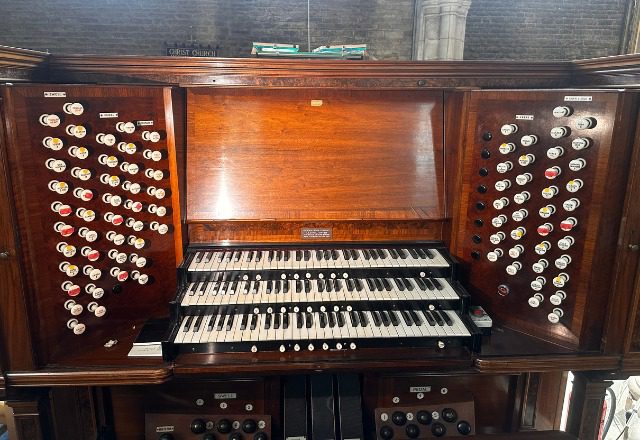My day started off badly when the phone rang on the way to work. Our service manager Peter was on the other end to tell me his van had broken down.
We were due at Christ Church Northampton later that day to complete the installation of an Envoy 350-FV and his van contained the plinth which was too large to go into our other van.
Weighing up our options
So, our options were to carry on, unable to complete the job, or try at short notice to find a plan B and get the plinth the 30 or so miles from Bicester to the church.
The matter was further complicated as Peter had an appointment near home later that afternoon so delaying the start of the job was also not possible.
On arriving at the office Peter jumped into my car and followed our working van up to the church arriving more or less on time to complete the job by mid-afternoon. I then called around locally and secured a hire van, unloaded the plinth from the broken-down van and got to Northampton by about 11.00 am.
A wonderful surprise
Not at all my plan for the day but what an amazing surprise awaited me at the church.
As I walked in at the south door near the chancel, I immediately saw the back of what must be one of the most beautiful organ consoles I have ever laid my eyes on. Book matched veneer panels as crisp as the day they were made came into view and immediately I was perplexed as to why this masterpiece had been taken out of use.
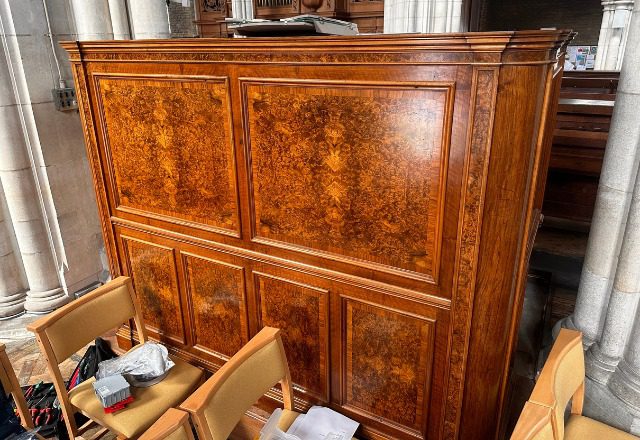
The story was shortly to be revealed and is so interesting I had to write this blog as soon as I got back to the office.
A musical gift from a shoemaker
I immediately tried to open the console without success presuming it to be locked. Later I met the organist’s husband who told me the instrument was built by the Aeolian Company in the USA.
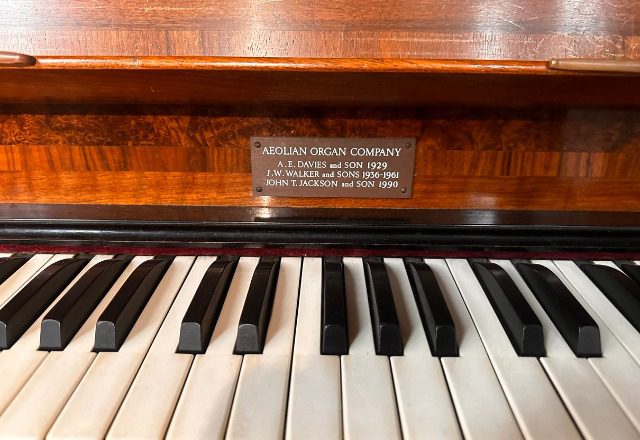
I asked if he had the keys and he confirmed it was not locked but I did not push the point while he went on to explain the instrument had started life in 1929 in the ballroom of a local mansion, the home of one of Northampton’s numerous Victorian or Edwardian shoe making millionaires, RJ Barratt.
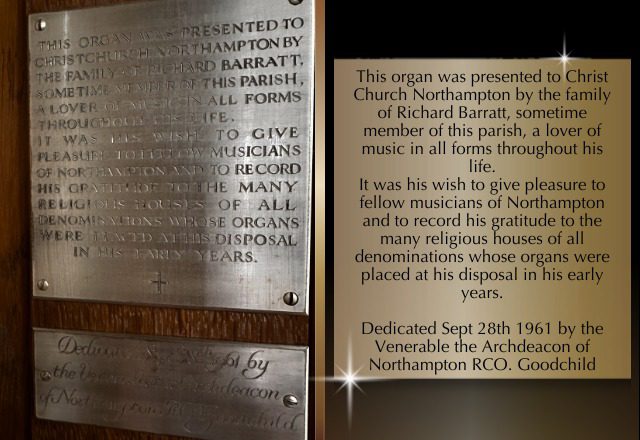
It was a gift to the church in 1961, but in hindsight had been a gift better declined as the instrument had cost a fortune over the years and like so many instruments over time had been altered. While case work and console were magnificent the pipework apparently did not inspire.
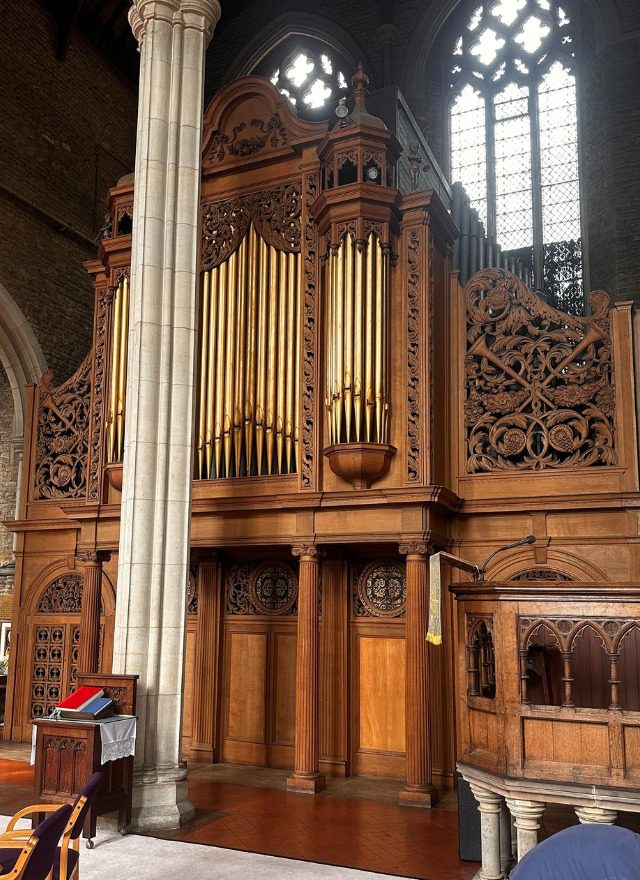
Stunning and curiously crafted organ
Can you imagine walking into a private home and being confronted by this instrument?
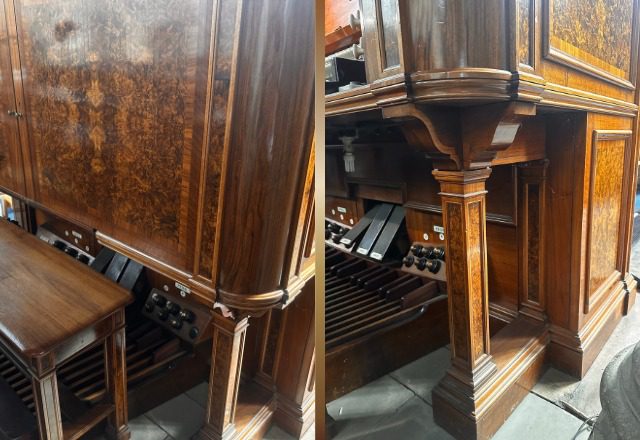
Perhaps not quite the impact of the Blenheim Palace library instrument, but not far behind. Like Blenheim, it also had an automatic player machine no longer present and as you will see on the NPOR listing it has a huge stop list. I gather much is extension pipework essential to house this huge instrument in what would otherwise be too small a space.
Getting back to the console now I was even more intrigued to see what lay behind the console doors and was getting frustrated that I could not pull them open.
Through the small gap I could see that the lock was not engaged so why on earth did they not open? And finally, I worked it out. They were sliding doors that like a tambour top desk were made from finely slatted timber mounted on a fabric back so as they moved sideways they disappeared and turned through 90 degrees coming to rest parallel with the sides of the console.
In all my 60+ years of visiting organs I have never seen that before. So well made are the doors, again with beautiful book matched veneer echoing the rear and side panels, that I did not see they were made of numerous thin vertical strips.
This is the video of me opening the right-side door.
Such amazing craftsmanship and also after almost 100 years as fresh as they day it was made. So, console and pipe case crossed the Atlantic in 1929 and then in 1961 moved from a house in Kingsthorpe to Christ Church. All work that must have been done with very great care.
A pleasant gem to end a day that start badly
I hope one day this unusual and beautiful instrument may find a deep pocket friend and once again come to life in the church. If you look at the pictures of the jambs you will see many of the stops with paper labels indicating that they no longer work reliably or at all.
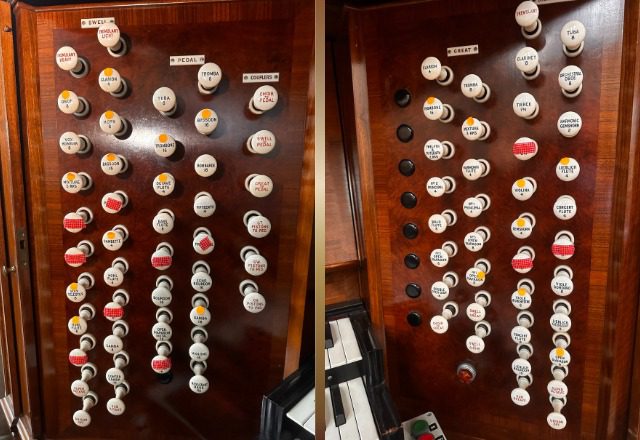
Like so many pipe organs it is a slow but relentless journey to a point where the cost of restoration is so large it is beyond all but the wealthiest of custodians to undertake.
So, the day started off on a bad foot, but had it not led to the need for me to take a plinth to Northampton, I may never have realised just what a treasure this church has inside.
I have had a passion for church organs since the tender age of 12. I own and run Viscount Organs with a close attention to the detail that musicians appreciate; and a clear understanding of the benefits of digital technology and keeping to the traditional and emotional elements of organ playing.
